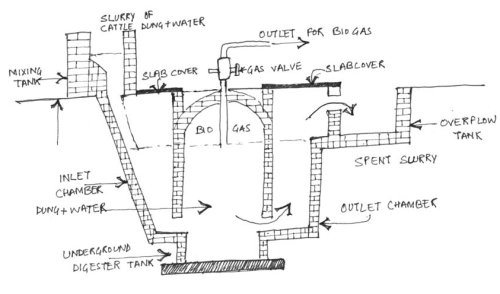<<< Previous
|
|
Chapter III
> >>
|
| COMPOSTING |
| Goto Technical details |
Composting is an aerobic process in which bacteria and other organisms feed
on organic material and decompose it. Composting (one material) and
co-composting (two or more materials) represent generally accepted
procedures to treat excreta.
Technical Details
To start the composting process, the blended compostable material is placed in windrows (long or round piles). The 'recipe' combines high-carbon and highnitrogen materials. Air is added to maintain aerobic conditions, either by turning the windrows or by forcing air through them. To adequately treat excreta together with other organic materials in windrows, the WHO (1989) recommends active windrow co-composting with other organic materials for one month at 55-60 C [60 degree Cellious], followed by two to four months curing to stabilise the compost. This achieves an acceptable level of pathogen kill for targeted health values. Adding excreta, especially urine, to household organics produces compost with a higher nutrient value (N-P-K) than compost produced only from kitchen and garden wastes. Co-composting integrates excreta and solid waste management, optimizing efficiency.
Technical Details
To start the composting process, the blended compostable material is placed in windrows (long or round piles). The 'recipe' combines high-carbon and highnitrogen materials. Air is added to maintain aerobic conditions, either by turning the windrows or by forcing air through them. To adequately treat excreta together with other organic materials in windrows, the WHO (1989) recommends active windrow co-composting with other organic materials for one month at 55-60 C [60 degree Cellious], followed by two to four months curing to stabilise the compost. This achieves an acceptable level of pathogen kill for targeted health values. Adding excreta, especially urine, to household organics produces compost with a higher nutrient value (N-P-K) than compost produced only from kitchen and garden wastes. Co-composting integrates excreta and solid waste management, optimizing efficiency.
- Co-composting with organic household waste is an option.
- It is important to turn the material a number if times for it to be evenly heated and allow complete maturation of the compost

Treatment by Dehydration
In double vault dehydration systems, excreta will partly dry inside the vault as a result of sun radiation, natural evaporation and ventilation. Absorbents such as lime, ash or dry soil should be added to the chamber after each defecation in order to absorb moisture, making the pile less compact.
Treatment by anaerobic digestion
In a digestion process, organic matter from human, animal or vegetable waste is broken down by microbiologcal activity, in the absence of air. This anaerobic process produces a combustible gas, methane, a source of (biogas) energy. The digestion process takes a couple of weeks to a couple of months after which the remaining slurry can be removed, either continuously or batch-wise. A domestic anaerobic digestion technique 'fixed dome type' consists of a simple biogas tank with a flat bottom and a round chamber covered with a dome shaped concrete gasholder. The gas is captured in the upper part of the digester. Gas pressure increases with the volume of gas stored, pushing the slurry into a separate outlet tank.
In a digestion process, organic matter from human, animal or vegetable waste is broken down by microbiologcal activity, in the absence of air. This anaerobic process produces a combustible gas, methane, a source of (biogas) energy. The digestion process takes a couple of weeks to a couple of months after which the remaining slurry can be removed, either continuously or batch-wise. A domestic anaerobic digestion technique 'fixed dome type' consists of a simple biogas tank with a flat bottom and a round chamber covered with a dome shaped concrete gasholder. The gas is captured in the upper part of the digester. Gas pressure increases with the volume of gas stored, pushing the slurry into a separate outlet tank.

|
Further Readings:
|
| Smart Sanitation Solutions Examples of innovative, low-cost technologies for toilets, collection, transportation, treatment and use of sanitation products http://www.irc.nl/content/download/24282/273405/file/SSS_2006.pdf |
| Closing The Loop: Ecological Sanitation for Food Security. Steven Esrey & Others. UNDP/SIDA, January 2001. http://www.ecosanres.org/pdf_files/closing-the-loop.pdf [C.eldoc1/d70d/closing_the_loop_ecological_sanitation_sida.pdf] |
|
Evaluating Ecological Sanitation -ASociotechnicalApproach
by Ketil
Haarstad, Henrik Lystad and William Warner. Internet
Dialogue on Ecological Sanitation, 2001
[C.eldoc1/d70d/Evaluating_Ecological_sanitation.html] http://www.ias.unu.edu/proceedings/icibs/ecosan/haarstad.html |
|
Health Aspects of Ecological Sanitation - Aussie Austin.
Internet Dialouge on
Ecological Sanitation, 2001.
[ C.eldoc1/d70d/Health_Aspects_ecological_sanitation.html] http://www.ias.unu.edu/proceedings/icibs/ecosan/austin.html |
| For a list of contractors for installation of biogas plants refer to Annexure 5- Resources/Organisations |
|
|
<<< Previous
|
|